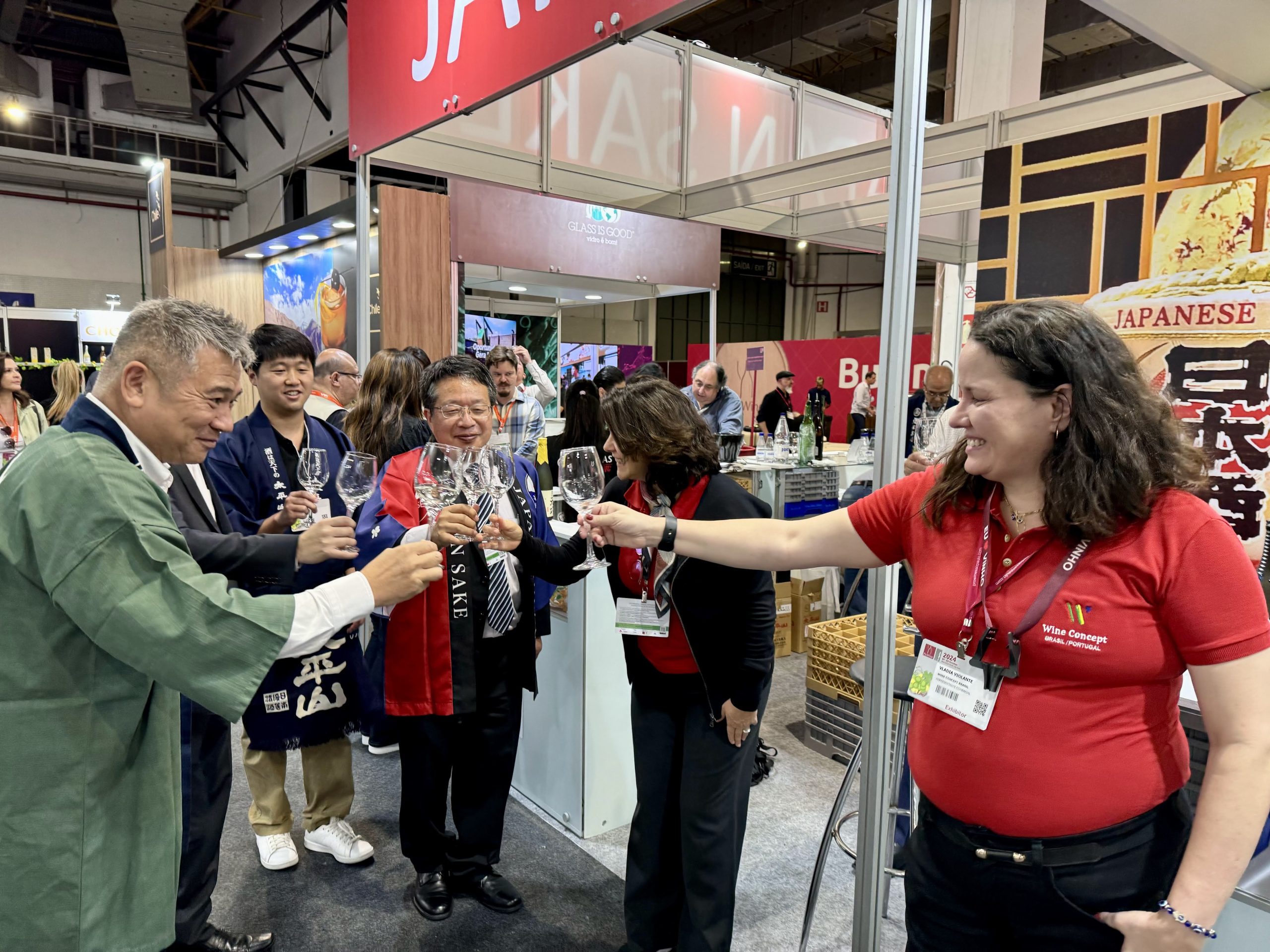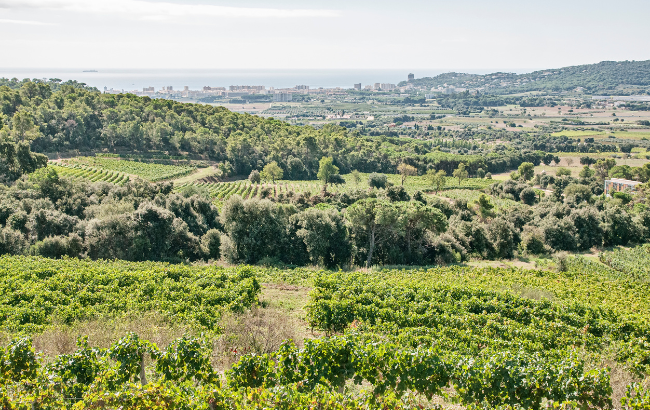Wine List Confidential: Restaurant Story
By Douglas BlydeDouglas Blyde takes in the the newly-reopened Restaurant Story in Southwark. Has the £2.5 million refurb been to the benefit of the cellar, or is it all just style over substance?
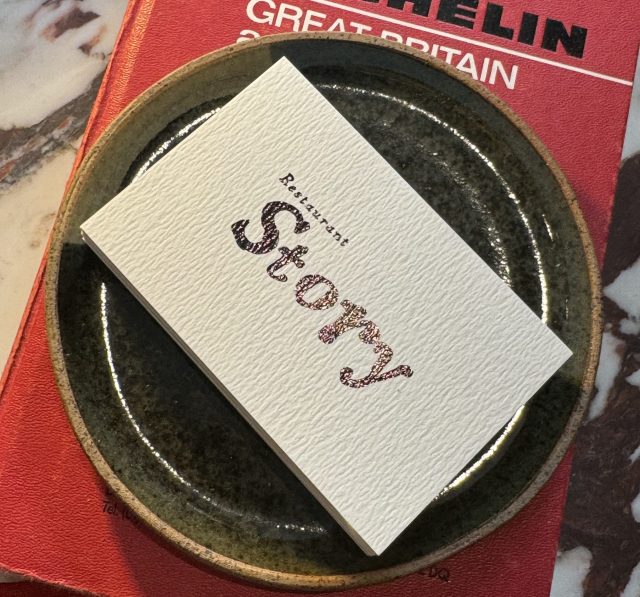
“So what has changed?” asked City AM’s lifestyle editor, Steve Dinneen, of Restaurant Story which reopened in January post a reported £2.5 million enlarging overhaul. “Well, the dining room looks pretty darn similar,” continued the Manchester-born, former Young Journalist of the Year, adding that chef-patron, Tom Sellers, “decided to simply build more of it. There’s now an entirely new level – a second storey!”
Design
Initially envisioned in a minimal “Rough Luxe” manner by the Shoreditch-based Raven Collective, Restaurant Story has, eleven years on, been enhanced by the same firm. Attention in the 32-cover ground floor dining room has been lavished on acoustics, tailored tableware, and art, with site-specific commissions by The Connor Brothers, while a flock of decorative swifts, cleaned weekly, hovers from the ceiling. Buffed concrete floors, which must be hard on the front-of-house team, meet a chalet-like wall enfolding the glazed kitchen, which is dominated by the instruction to “Focus”. At its prow is a Bibendum mascot, abutting colourful pickling jars. A trolley formed from railway sleepers and patinated copper was moored beside our table almost all lunchtime, on which a lobster press, which didn’t apply to our menu, gleamed.
Accessed from the former fire escape, a gallery-grade staircase leads to the third bank of wine fridges, then a discrete lounge stacked with Sellers’ book, “A Kind of Love Story”. An open kitchen and dining room for circa sixteen follow beneath a ceiling festooned with lily pad-like shapes. Doors open to a comfortable cigar terrace, its balcony seizing the sights of Tooley Street, including the immediate statue of Samuel Bourne Bevington, first mayor of Bermondsey, and bust of trade union leader, Ernest Bevin. From below, this vantage, evocative of the pinnacle of an air traffic control tower, must be one of the area’s most striking buildings.
Noting chef-patron, Tom Sellers is “obsessed with noise” according to head of beverage, Jonathan Kleeman, the soundtrack is rarely dull, including Red Right Hand (Nick Cave and The Bad Seeds), Lullaby (The Cure), and Cold Little Heart (Michael Kiwanuka). This plays from attractively retro speakers as bold in volume as the flavour gauge of the always memorable, though sometimes discordant dishes.
Drinks
Leighton Buzzard-born head of beverages, Jonathan Kleeman worked as “director of hydration” at Twisted Cellar, Bishop’s Stortford (RIP), and in London as head sommelier and cigar buyer at Four Degree (RIP), and head sommelier for Laure Patry at Jason Atherton’s Social Eating House where he refined cocktail making skills at The Blind Pig. Formatively, he also spent two years at The Ritz, when the likes of A. A. Gill was a regular, “learning Italian” alongside an otherwise all-Italian sommelier ensemble. Originally set for a career in economics and politics, it was perhaps on account of the early exposure to hospitality via his pub chef father, which assured his ultimate calling.
The literate Kleeman, whose words have appeared in Rolling Stone, also oversees liquid assets at Story Cellar at Seven Dials, famed for its rotisserie chicken and house terrine, and Dovetale, billed as a “haven for reimagined European classics” at Barry Sternlicht’s sustainably-inclined 1 Hotel, Mayfair. There is an international catering arm, too, “Once Upon A Time”, whose partners include: Apple, Rolls Royce, and Audemars Piguet watches, with macro versions of the latter hanging prominently in Restaurant Story’s open kitchens.
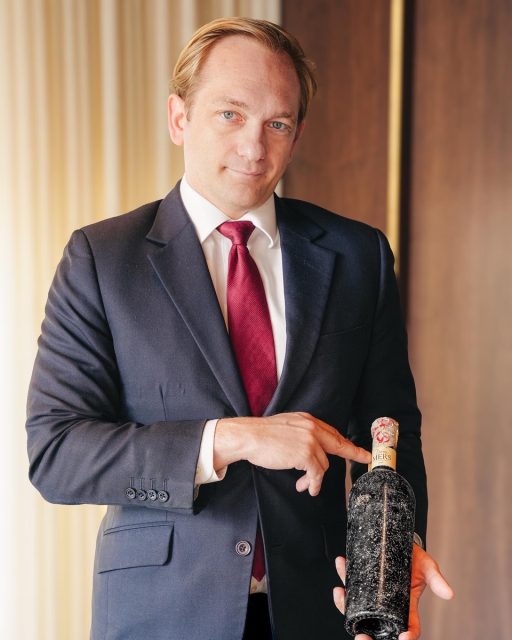
Wine fridges are set at 15.5 degrees Celsius for reds, and 13.5 for whites. Served in Mark Thomas stems, dry wines by the glass range from red Douro blend, Alice Vieira de Sousa Reserve 2021 (£9 per 125ml) to Thierry Allemand’s organically-tended Cornas Les Chaillots 2019 (£115), via one of two Serbian options, being 2017 Chardonnay “Marmalade” in name, hue, and perhaps flavour, by Deurić (£12), a 2021 Oregon Grüner Veltliner – Meeresboden – “ocean soil” (£21) and the 2017 instalment of Clos Rougeard’s old vine Saumur-Champigny Les Clos, typically restrained to 3,000 bottles (£80).
By the bottle, sparklers open with 2019 Artelium Makers Rosé from the South Downs (£90), topping out at £650 for, from the son of Anselme Selosse, Guillaume Selosse’s NV Largillier. In between, the low intervention – something of a theme of Story – Le Chapitre Rosé NV Berru (Jacques Picard) is £125, while Pol Roger Cuvée Sir Winston Churchill 2006 costs £465, and Dom Pérignon Rosé 2005 may be yours for £600.
Still bottles stretch from the meek in every sense, 2022 Château Pesquie Viognier Vin de Pays at £40, to £2,200 for 2020 Le Montrachet Grand Cru (Domaine Blain Gagnard). Although the latter shows a mark-up of around £1,000, there are in excess of 100 bins under £100, with seven at, or below, £50. Notable whites include The Slint 2022 dawn picked Chardonnay from “holistic” sommelier favourite, Ochota Barrels (£115), biodynamic, Fattoria San Lorenzo Bianco 2009 from a former master cooper in Marche (£170), Didier Dagueneau’s 2018 Silex (£365), and Kongsgaard’s lavish 2020 The Judge Napa Chardonnay (£600).
Reds include 2020 “Ypsilon” from Tenuta di Castellaro, said to deliver the “frankness and good cheer of Sicilian winemaking” according to Monica Larner (£60), a curious 2005 release of Burgenland Zweigelt two vintage blend “Rescued” by Somm in the Must (£90), the promising third iteration (2019) of Château Berliquet under the tenure of Chanel of Canon, Rauzan-Ségla, and perfume and handbags fame (£155), the “herbal” (said Wine Spectator) 2004 Dry Red No. 1 Cabernet by Yarra Yering (£295), and 2017 ARK from Napa’s daring Hundred Acre Wines (£1,200)
Sweet provisions include the 50cl of 2020 Vin de Laurence Moelleux from a former glove-maker at Mas de Daumas Gassac, encapsulating Muscat and less usually, Sercial (£260), and a Swiss pear ice cider from Cidrerie du Vulcain (£115).
Perhaps mirroring a Britain subjected to fourteen years of Conservative rule, Kleeman reflected on the divide betwixt high-flyer guests readily ordering more top-tier wines than ever versus those resolutely adhering to the opening echelon while resisting an aperitif or digestif. “It’s harder to sell the middle of the pack.”
Kleeman previously told Drinks Business he values spirits as much as wine. “I never understand why sommeliers don’t cross the divide. It’s all alcohol, guys – we should know both!” While noting the presence of a few dark spirits offering drama by the dram such as Aberlour Lombard Jewels of Scotland 1970 (£45 per double), disappointingly, a few of the listings convey the feeling of browsing the aisles of a duty free concession.
Kleeman is assisted by the Pennsylvanian theologian, Sean Crosby, and Jake Garstang (formerly of Casamia, Bristol).
Dishes
Story’s brigade is overseen by two Toms: Nottingham-born chef-owner and Burgundy lover Tom Sellers (formerly of Tom Aikens, Noma, Per Se, and Trinity) and his Welsh executive chef, Tom Philipps (The Ritz, Per Se, L’Enclume). Today’s dishes were delivered by Peruvian-born head chef Danny Khoury.
Lunch opened with an initially unidentified broth which transpired, after our guesses were exhausted, to be formed from an entire lemon, blanched, salted, then cooked to blackness in a bag for three months at 60 degrees. Coal-like in appearance, one such spent citrus fruit was presented perhaps for Instagram before being conveyed to fellow curious diners. “Sometimes chefs have too much time on their hands,” joked our restaurateur guest. Combined with a vegetable consommé, the result was welcomingly succulent.
Partner Content
Snacks followed, served, in part, on covetable Luesma + Vega tableware echoing the two tones of Restaurant Story’s own tablecloths. Carlingford Lough oyster was heartily though anonymously encapsulated in what was described as “lardo tempura”, being crisp yet oily, with a bitter bavarois featuring cucumber pearls concealed beneath. The “Storeo” may well have disappointed an eager child expecting its Oreo double, given Sellers’ version layered chocolate, barely discernible truffle, and very apparent aged Montgomery cheese which seemed to have a whiff of the linen in which it was once aged. Lobster tartelette with lemon gel was beautiful, though studded with distracting, highly flavoursome, teeth-sticking seeds. And rabbit sandwich, encapsulating chicken mousse, and topped with a favourite food of the burrowing animal, being carrots, here pickled, evoked a Ginsters sausage roll – although not necessarily entirely negatively. This came with a well-judged tarragon sauce dip which the manager perplexingly joked would “go well” with the ensuing hot towel.
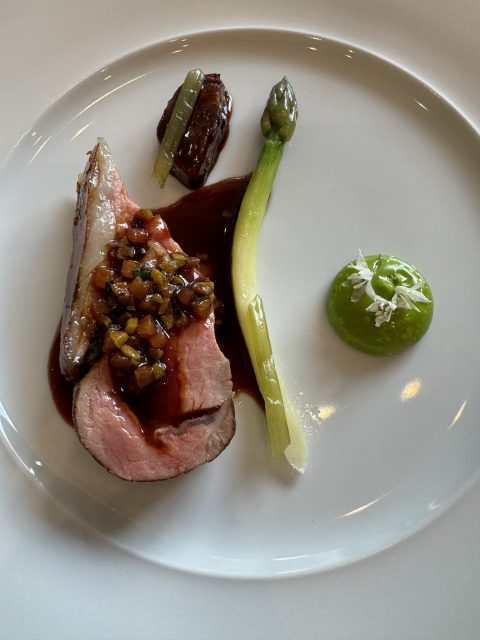
Perhaps showing Khoury’s influence, the first dish proper involved cubed hamachi “Chalaquita” with yellow Isle of Wight cherry tomatoes, and San Marzanos from Italy, dehydrated to heighten flavour, although the latter felt, texturally, like they had been poured from a can. Only the vanilla base notes of the dish harmonised with the confected, pinkish 9% sparkling sake match, made with native yeasts and finished with an ugly label suggesting aborted branding for a Love Hotel (Yonetsuru, Takahata, Japan). The melting jelly cap atop the dish unfortunately unattractively peeled off in one gelatinous piece regrettably reminiscent of the prophylactic recreated in the provocative “Sex on the Beach” dish devised by “The Demon Chef”, Alvin Leung. We wondered if this dish, intended, no doubt, as an ephemeral celebration, could be abridged into a more straightforward, less handled, format.
Despite the manager specifically asking at the start of lunch whether we harboured an aversion to caviar, which we are always pleased to refute, the next dish on our menu, an ephemeral English pea custard with caviar from supplier of the moment, N25, and charred spring onion, ostensibly served with an Italian Grüner Veltliner, failed to manifest. Instead, we were advanced to the “Candle”. Composed of beef dripping, the “wax” pools into a saucer, into which one dips a cross between panettone and Manna from heaven. It was offered with dips of supple beef extract and pickled celery, which were best combined in a 1:3 ratio. The only downside of this Story classic was that the pooling sauce began to look “smeggy” over time, said our guest. With it, we were served a riff on a “Pedrino”, said Garstang, in which Pedro Ximénez was “lengthened with mineral tonic water.” The effect was infantilising, a la Cola, though probably pleasing for the operator given the healthy margins involved. We suspect an older traditional method fizz with lavish autolytic character could better have served this iconic dish, being a homage by Sellers to his love for Sunday roasts. We wonder what would happen if such a dish, along with, for example, Ollie Dabbous’ nest egg at Hide, was cut, however? To “kill your darlings” in literature leads, perhaps, to a sharper narrative, and even greater imaination.
Again, team Story fast-forwarded us, this time by two citrus-pepped places, along the printed menu, omitting the service of “Half-Time Oranges”, and also agnolotti with burnt lemon, broad beans and mint, apparently accompanied with an Austrian Sauvignon Blanc.
Gift wrapped in unadulterated courgette, brown butter poached cod had an almost scallop-like texture and basked in a ratatouille, with a rich, Ritz-grade, saffron and red pepper sauce, and a pointless seeming “espuma” of some sort. “One Michelin-star restaurants serve turbot, while two stars serve cod because they have less to prove,” said our companion. To bring a gossamer lightness and gentle, varietal perfume to the impeccable sauce of this truly outstanding dish, we were poured one of the cheapest bottles in Story’s repertoire, being our first encounter with Serbian Pinot Noir. The first of two wines from Vinarija Deuric, this was a real find by Kleeman, being, said Garstang, a cross in profile between “Burgundy and California.” Suddenly, Sellers’ food made some sense when treated to decent wine rather than alcopop-evoking camply branded sake and undignified, frankly mood-changingly sugary faux Cola. Perhaps the contradictions in canapés, the ugliness of the Chalaquita further impaired by the liquid match, and barely defensible Cola, were sforzando moments to force us to awaken and pay Sellers’ kitchen our full attention? As per the psychiatrist, Carl Jung, “No tree can grow to Heaven unless its roots reach down to Hell.”
Lamb was initially presented for inspection as a whole rack, then disappeared and reappeared as a cutlet freed from the bone, and, cured overnight, then braised for nine hours, the belly. The latter was prune-like in appearance, being the definition of savoury, while its translucent, glazed fat, finished with a blowtorch, was so inviting, it proved the first line of attack with our Robbe & Berking silver knife. The again dazzling dish, a bravura in its simple-seeming composition, was finished with a sauce of lamb jus, including fat, basil, “tomato concentrate” said the manager, and olives. A spear of Wye Valley asparagus, was supplemented with a glossy wild garlic mayonnaise. Alongside, the dependable third wine of Château Margaux provided identifiable, classy, Bordeaux character, being a very classic match. However, no sooner had it been poured, then Kleeman finally arrived on the floor “suited and powdered” according to the manager.
However competent understudies may be, we had booked, well in advance, to see the main act. And it arrived armed with a wonderful, off-list bottle. Representing the meal’s second meeting with Vinarija Deuric in Fruška gor, northwestern Serbia, Grand Trianon Deux Mers 2016 is limited to just one thousand bottles, a successful version of an apparently unsuccessful experiment started in 2012. Having been grown on a former sea bed, the bright blend from a coral-marked bottle of Cabernet Sauvignon, Merlot, and Shiraz was subsequently aged 30 metres below the sea. “I have compared two vintages side-by-side, and can see a marked effect in the natural acidity, not the nose,” shared Kleeman, with the nautically aged expressions of both 2016 and 2019 being “more linear, taught.”
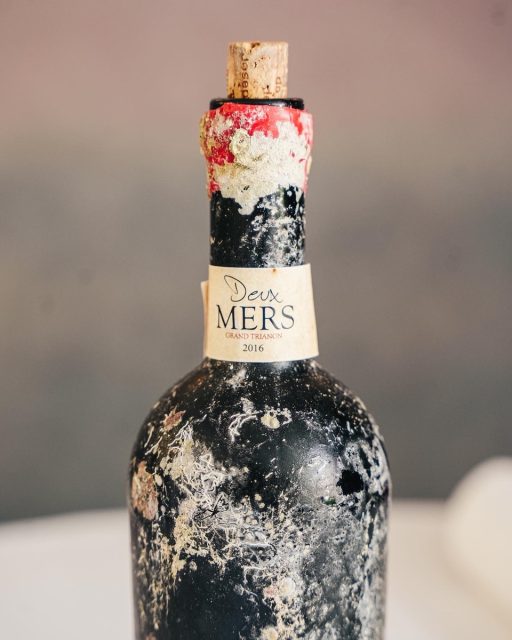
Onto the pre-dessert entitled “Citrus”, in which a kaffir marshmallow with a lemongrass custard infused with coffee beans, was blowtorched at table. Alas, it was another sforzando, more slap than tickle. The marshmallow, when melting, was hard to cut, and the accompanying grapefruit segments were hard-line given their acuity of acidity. Domaine Christian Binner’s 2003 Hinterburg Muscat Grains Nobles did its best to gently curl around the corners, though ultimately, went missing.
Dessert proper brightly collaged a delightful blood hued red velvet strawberry sandwich with a vanilla yogurt parfait contrasting a frustrating wiry tangle of lemon balm, and an almost architectural dehydrated tuille. This was finished with a nostalgically ice cream van grade coulis. With this, a powerfully alcoholic, strawberry bon bon cocktail combined Bombay Sapphire’s so-called Premier Cru expression with crème fraise du bois, crème de cacao, and aerated cream. It was, alas, as unbalanced as a jet-lagged tightrope walker.
Treats ensued, comprising, on an elevating stand, a “Tribute to Paddington” being a marmalade sandwich of toasted pain perdu, marmalade, cream, mascarpone, spicy breadcrumbs, and, unsuccessfully, foie gras, as well as macadamia nuts rolled “six times in chocolate”, pink peppercorn dusted elderflower fudge, and finally, mouth puckering oranges, which had been “blanched ten times”. The latter were bitter peels to swallow.
Last word
Over a Guinness at The Two Bridges Ale House & Kitchen within sight of the magnificent architecture of Restaurant Story #3.0, we brought to mind for the second time this year, the words of restaurant blogger Chris Pople after his visit to El Bulli, close to just Dalí’s home, fifteen summers ago. He compared his 20-plus course journey to the White Album by The Beatles. “It’s one-third brilliant and listenable (Blackbird, While My Guitar Gently Weeps, Dear Prudence), one-third challenging and experimental, but still just about accessible (Happiness Is a Warm Gun, Julia, Glass Onion), and one-third bizarre, unlistenable trash (Wild Honey Pie, Why Don’t We Do It In The Road?, Revolution 9)…”
Today’s lunch, despite a deficiency of conspicuously luxurious ingredients, sometimes jarring flavours and textures, as well as a dearth of the expected story telling, had delivered two undoubtedly masterly dishes in succession. These felt heightened when decent wine was applied, with cooking elsewhere diminished, as per the spectacular brioche, when it was not.
When considering the meal’s nadirs, it was too tempting a chance not to reference the cover of The Connor Brothers’ unkind take on a Penguin Classic, “A Load of Fuss About F*ck All”, displayed in Story’s second storey. Our Final Thought, however, is hopefully a little more eloquent. Tom Sellers’ kitchen, operated by a remarkably devoted team, continues unilaterally to push boundaries in an increasingly timid London. A city where we received, on one day alone, no fewer than four press releases heralding new sleep-inducing “grand brasseries” with Prix Fixe menus. To resuscitate the jaded of palate and the formulaic of thought, a visit to Story, with all its crotchets, delivers a reverse substation’s worth of defibrillation…
Best for
- The expertise, far-reaching sourcing, and often accessible pricing of wines by Jonathan Kleeman
- Producer dinners, including forthcoming events with Chris and Andrea Mullineux
- High-quality fit and finish of the venue
- Playlist chosen by the chefs
Value: 94, Size: 94, Range: 96, Originality: 99, Experience: 96; Total: 95.8
Restaurant Story – 199 Tooley Street, London, SE1 2JX; 0207 183 2117; dine@restaurantstory.co.uk; restaurantstory.co.uk
Related news
What's driving Burgundy trading?
Hospices de Nuits-Saint-Georges auction: bucking the trend
Data-driven and AI-analytics: the changing dynamics of the fine wine market


